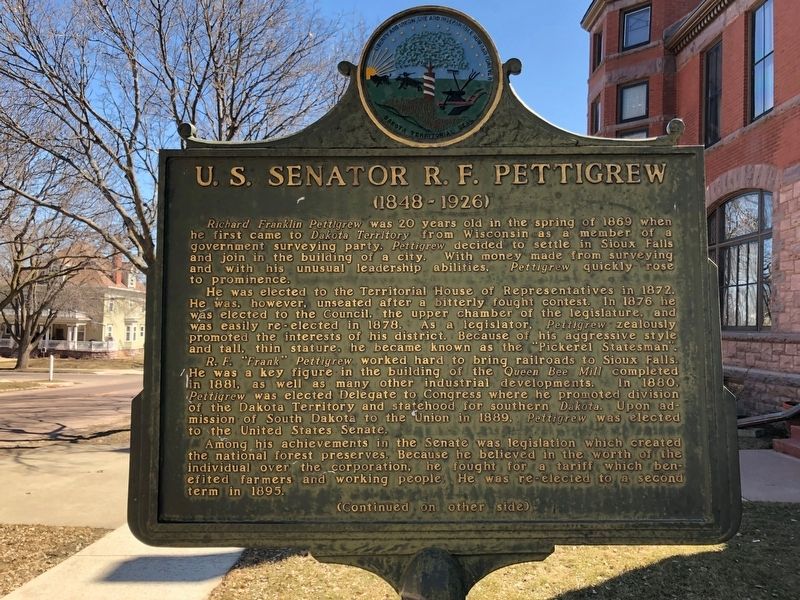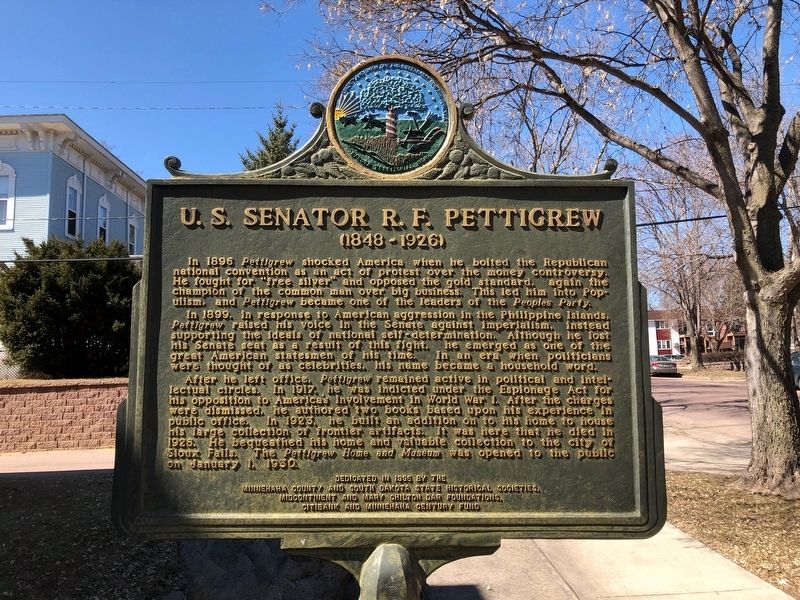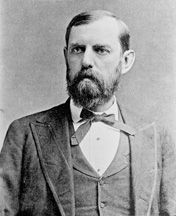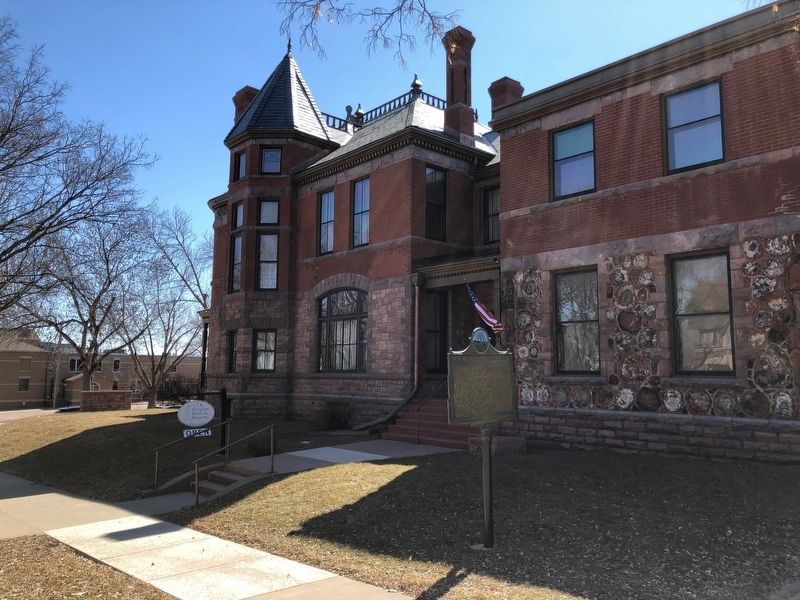Axtell Park in Sioux Falls in Minnehaha County, South Dakota — The American Midwest (Upper Plains)
U.S. Senator R.F. Pettigrew
(1848-1926)
Richard Franklin Pettigrew was 20 years old in the spring of 1869 when he first came to Dakota Territory from Wisconsin as a member of a government surveying party. Pettigrew decided to settle in Sioux Falls, and join in the building of a city. With money made from surveying and with his unusual leadership abilities , Pettigrew quickly rose to prominence.
He was elected to the Territorial House of Representatives in 1872. He was, however, unseated after a bitterly fought contest. In 1876 he was elected to the Council, the upper chamber of the legislature, and was easily re-elected in 1878. As a legislator, Pettigrew zealously promoted the interests of his district. Because of his aggressive style and tall, thin stature, he became known as the "Pickerel Statesman".
R.F. "Frank" Pettigrew worked hard to bring railroads to Sioux Falls. He was a key figure in the building of the Queen Bee Mill completed in 1881, as well as many other industrial developments. In 1880, Pettigrew was elected Delegate to Congress where he promoted division of the Dakota Territory and statehood for southern Dakota. Upon admission of South Dakota to the Union in 1889. Pettigrew was elected to the United States Senate.
Among his achievements in the Senate was legislation which created the national forest preserves. Because he believed in the worth of the individual over the corporation, he fought for a tariff which benefited farmers and working people. He was re-elected to a second term in 1895.
In 1896 Pettigrew shocked America when he bolted the Republican national convention as an act of protest over the money controversy. He fought for "free silver" and opposed the gold standard, again the champion of the common man over big business. This led him into Populism, and Pettigrew became one of the leaders of the Peoples Party.
In 1899, in response to American aggression in the Philippine Islands, Pettigrew raised his voice in the Senate against imperialism, instead supporting the ideals of national self-determination. Although he lost his Senate seat as a result of this fight, he emerged as one of the great American statesmen of hiss time. In an era when politicians were thought of as celebrities, his name became a household word.
After he left office, Pettigrew remained active in political and intellectual circles. In 1917, he was indicted under the Espionage Act for his opposition to America's involvement in World War I. After the charges were dismissed, he authored two books based on his experience in public office. In 1923, he built an addition on to his home to house his large collection of frontier artifacts. It was here that he died in 1926. He bequeathed his home and valuable collection to the city of Sioux Falls. The Pettigrew Home and Museum was opened to the public on January 1, 1930.
Erected 1995 by Minnehaha County and South Dakota State Historical Societies, Midcontinent and Mary Chilton Daughters of the American Revolution (DAR) Foundations, Citibank and Minnehaha Century Fund. (Marker Number 660.)
Topics and series. This historical marker is listed in these topic lists: Government & Politics • Settlements & Settlers. In addition, it is included in the Daughters of the American Revolution, and the South Dakota State Historical Society Markers series lists. A significant historical date for this entry is January 1, 1930.
Location. 43° 32.911′ N, 96° 44.097′ W. Marker is in Sioux Falls, South Dakota, in Minnehaha County. It is in Axtell Park. Marker is on W 8th Street, 0.1 miles west of S Duluth Avenue. Marker is located at the Pettigrew museum. Touch for map. Marker is at or near this postal address: 623 W 8th Street, Sioux Falls SD 57104, United States of America. Touch for directions.
Other nearby markers. At least 8 other markers are within walking distance of this marker. Prehistoric Prayer Rock (here, next to this marker); 215 N Duluth Avenue (about 300 feet away, measured in a direct line); The People's Party National Convention (about 500 feet away); Kaufmann House Mystery (about 500 feet away); Two Cemeteries (about 600 feet away); The Woman's Alliance (about 700 feet away); Dakota Conflict (about 800 feet away); Cathedral Historic District / Paving Stone Alley (approx. 0.2 miles away). Touch for a list and map of all markers in Sioux Falls.
Also see . . .
1. Richard F. Pettigrew. (Submitted on April 10, 2019, by Ruth VanSteenwyk of Aberdeen, South Dakota.)
2. Pettigrew Home & Museum. Wikipedia entry (Submitted on December 19, 2023, by Larry Gertner of New York, New York.)
Credits. This page was last revised on December 19, 2023. It was originally submitted on April 10, 2019, by Ruth VanSteenwyk of Aberdeen, South Dakota. This page has been viewed 348 times since then and 55 times this year. Last updated on October 27, 2021. Photos: 1, 2. submitted on April 10, 2019, by Ruth VanSteenwyk of Aberdeen, South Dakota. 3. submitted on December 19, 2023, by Larry Gertner of New York, New York. 4. submitted on April 10, 2019, by Ruth VanSteenwyk of Aberdeen, South Dakota. • J. Makali Bruton was the editor who published this page.



